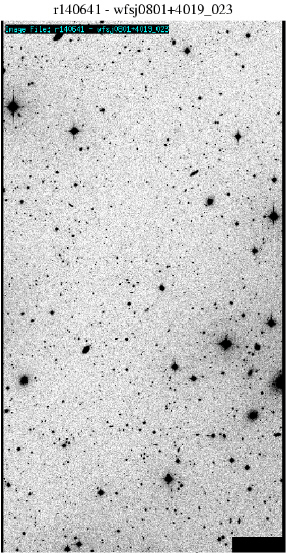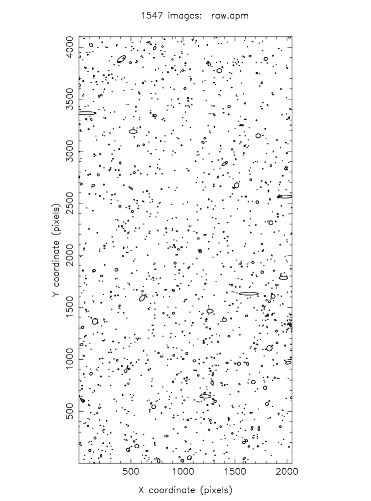- field patches will be 3 x 3 deg2 for all except the Dalton and van Paradijs fields.
- exposure times ~600 to 800s per filter (1200s for U), and 2400 to 3600s for the Dalton fields.
- the initial runs used the Harris UBVRIZ filter set due to delays in obtaining the Sloan Gunn filters. By July 1999 the g', r' and i' filters had been acquired and are now being used. The U and Z filters are similar to the u' and z' filters. See http://www.ing.iac.es/~quality/filter/newfiltdoc.html for details.
- de-biased and trimmed.
- bad pixel replaced.
- non-linearity corrected.
- flat fielded.
- de-fringed (i' and z' data only).
- gain corrected.
- astrometric solution applied.
- photometrically calibrated.
- object catalogues generated.
- Observing logs built from the FITS headers.
- A 'sybase' user interface to access. the raw and processed data.
- Library bias frames, flat-field frames, defringing frames and non-linearity corrections.
- Colour equations for all filters.
- Processed 2D image maps, with a full record of processing steps in the FITS headers.
- Astrometric calibration, with the World Coordinate System in the FITS headers.
- Photometric calibration – zero points and extinction.
- Data quality control plots.
- Object catalogues, generated using APM based routines (Irwin, 1985) and possibly SExtractor (Bertin and Arnouts, 1996) to give positions, magnitudes, image quality, etc. These will be stored as FITS binary tables with original 2-D image frame headers.
- Multicolour object catalogues, with cross-referencing of colour data to provide sub-sample selections based on colour-colour diagrams.
- An improved user interface to the WFS archive via the WWW front end, giving, for instance, the ability to extract arbitrary regions etc.
- Improved cross referencing to other survey data (e.g. FIRST, 2dF, AXAF) available for WFS fields.
- Association with reddening maps and HI maps.
| The ING Newsletter | No. 1, September 1999 |
| GENERAL | TELESCOPES AND INSTRUMENTATION | OTHER NEWS FROM ING | TELESCOPE TIME |
Previous: Contacts at ING | Up: Table of Contents | Next: Extragalactic Stellar Spectroscopy
The Isaac Newton Group's Wide Field Survey. Status of the Survey and Associated Data Pipeline
Nicholas A. Walton
(ING), Mike Irwin, Richard McMahon, James R. Lewis (IoA)
The Isaac Newton Group's Wide Field Survey (optical) (WFS) is using the Wide Field Camera (~0.3 deg2 ) on the 2.5m Isaac Newton Telescope (INT). The project was initiated in August 1998 and is expected to have a duration of up to five years.
The WFS is an umbrella for competitively judged science programmes which were assessed on the usual criteria plus the wider worth of the data set and the management competence of the proposing teams.
Multicolour data will be obtained over 200+ square degrees to a typical depth of ~25 mag (u' through z'). Importantly, the data is publically accessible by the UK and NL communities from day one, with access to the rest of the world after one year.
The preliminary processing and calibration (up to object catalogue generation) is the responsibility of the WFS project.
Full information can be obtained at http://www.ing.iac.es/WFS/. These pages also provide links to in press and forthcoming publications describing various aspects of the WFS.
Introduction
In recent years a number of major survey programmes covering a variety of wavelengths have been initiated. The 2Mass project is covering the entire sky at a resolution of 4 arcsec in the JHK bands (http://www.ipac.caltech.edu/2mass/) The Sloan Sky Survey (SDSS) (http://www.sdss.org/) will cover significant areas of the Northern Hemisphere. These wide area surveys are having a significant impact, both as target selectors for 8 m class telescopes and for inherent survey science programmes.
This article briefly describes the Isaac Newton Group's Wide Field Survey (WFS). This aims to provide deeper data than the SDSS, but still cover significant targeted coverage, typically of fields being observed by facilities at other frequencies.
The Isaac Newton Telescope and the Wide Field Camera
The WFC is an array camera of four 4k×2k thinned EEV CCDs (with excellent QE, read noise, full well, cosmetics, etc). It has 0.33 arcsec/pixel, this matches to the Roque de Los Muchachos Observatory median seeing of 0.7arcsec. The WFC has a 0.29 square degree field. This is large for a 'thinned CCD' mosaic, and is approximately equal to the coverage of ESO's WFI@2.2m. The WFC currently takes some three minutes to readout, although this will be reduced to one minute in September 1999, and to 30 s in 2000 Q1.
The CCD broadband zero points
(mag for 1 photon/s) and 5 sigma detection limits, assuming a dark sky
and 1.2 arcsec seeing, are:
|
|
|
|
|
|
|
|
|
|
|
|
|
|
|
|
|
|
|
|
|
|
|
|
|
|
|
|
|
|
|
|
|
|
|
The ING Wide Field Survey
The concept of the survey was originally proposed to the ING's Joint Steering Committee (JSC) (now the ING Board) by Walton and Irwin. The primary goal was to exploit the excellent capabilities of the WFC in a timely fashion over a period of 4–5 years and allow instant access to the processed data to facilitate its rapid scientific exploitation.
The Survey proposal was approved by the JSC in October 1997 with a subsequent 'Announcement of Opportunity' closing in March 1998. The WFS International Review Panel approved three main programmes in the first year, allocating five–six 'dark/grey' weeks per semester to the WFS. In June 1999 a first year review was carried out by PATT and the International Review Panel, this confirmed the continuation of the first year WFS programmes into 2000.
The Survey data is available to all UK and NL based observers in near real-time. Raw data is typically available as taken, whilst the pipeline reduced data is available after one month. The data is available to the rest of the astronomical community after one year.
The WFS Programmes
The main science programmes were chosen to provide a 'wide' programme, a more focused smaller area programme, and a programme to address time variability.
INT Wide Angle Survey (WAS). PIs: McMahon, Irwin (IoA), Walton (ING) (see http://www.ast.cam.ac.uk/~rgm/int_sur)
This is the largest approved programme and includes sub-projects ranging from determination of cosmological parameters (e.g. via SN Type Ia studies) to searches for Solar System objects. It is the umbrella programme for the WFS project and leads coordination with the other programmes on, for instance, field, filter selection, to maximise scientific leverage of project.
The WAS additionally incorporates two distinct science programmes in the summer semesters centred on Virgo and the North Galactic Pole:
- A multicoloured large area survey. PI: Davies (Cardiff)
This aims to obtain the luminosity function (LF) of Virgo (using the u', g', z' filters) as a function of colour and position in the cluster down to L star of local dwarf spheroidals.
- The Millennium Galaxy Catalogue (MGC). PI: Driver (St Andrews) (see http://star-www.st-and.ac.uk/~spd3/mgc/mgc.html)
The MGC will provide a complete and local galaxy catalogue to faint limiting magnitudes (mB< 27 mags/ arcsec2 ) for low luminosity systems. It will contain ~5 million objects and be an important target generator for 8-m+ telescope science.
A Deep UBVRI Imaging Survey with the WFC. PI: Dalton (Oxford)
This programme is carrying out deep imaging of four contiguous regions of 10 deg2 to a limiting magnitude of B=26 and I=24.5. It will enable the study of the evolution of galaxy clustering as a function of colour at faint magnitudes and provide a catalogue of rich galaxy clusters at intermediate red-shifts. Further, quasars will be detected at z>5. In good seeing, observations of two 5 deg2 fields to U=26 are being observed to investigate clustering of Lyman-break galaxies at z>3.
Faint Sky Variability Survey (FSVS). PI: van Paradijs (Amsterdam)
This programme is searching an area of >20 deg2, studying photometric and astrometric variability on scales of one hour to a year to a magnitude of V=25. Example areas of investigation include: the evolution of specific galactic populations (e.g. CVs, RR Lyraes, halo AGB stars, brown and white dwarfs, Kuiper Belt objects, sdB stars), the structure of the galactic halo, statistics of optical transients related to gamma-ray bursts, and deep proper motion studies.
The first data run in November 1998 provided over 1600 new variable objects discovered in the first six nights.
Field Coverage to Date
Survey data is being obtained on a weekly basis and thus a summary of the data obtained will soon be out of date. A complete summary of observations obtained is kept on-line at http://www.ing.iac.es/WFS/.
The situation at the end of May
1999 was that ~60 deg2 had been observed in the first
ten months of survey.
|
|
|||
| Field | Comments | Colours | Area (deg2) |
| 0219-0500 | XMM region, NVSS & FIRST data | UBRIZ | 3 |
| 0354+0010 | SA95, NVSS & FIRST data | UBVRI(Z) | 4 |
| 0801+4019 | NVSS, FIRST, WENSS data | UBVRZ | 3 |
| Equatorial | Strip 10h<RA<15h, Dec 0d | Br' | 10 |
| Virgo | 12h39m, +12d27m | B | 9 |
| 1610+5430 | ELIAS-N1 region, NVSS, FIRST, WENSS | Z | 3 |
| 2240+0000 | 2dF region, SA114, NVSS & FIRST data | UBVRIZ | 5 |
| Pleiades | 03h47m, +24d00m | IZ | 8 |
| Dalton | 00h20m, +35d10m & 16h30m, +46d25m | BVRi'Z | 5 |
| FSVS | some CHANDRA fields | BVIZ | 10 |
| Notes:
|
Survey Progress: The Processing Pipeline
The WFS data is fully processed by the Project. After acquisition at the INT the data is transferred to the Cambridge Astronomical Survey Unit (CASU) at the IoA.
The data is then run through the
WFS pipeline:
An example of a single data
frame and the object catalogue image is shown in Figure 1.
 |
 |
| Figure 1. A processed 600s R band image (1.0arcsec image quality, ~11x22arcmins, this being one of the four images obtained in each exposure) is shown in the left panel [ JPEG | TIFF ], with the APM object catalogue representation on the right (~1600 objects are identified in this at the 5 sigma detection level). [ JPEG | TIFF ] | |
The images are archived, the headers are available via Sybase database and WWW front end. The raw data is available soon after acquisition.
Calibration libraries of master biases, flat fields, fringe maps, photometric calibrations are maintained and are available for download.
The astrometric calibrations are currently based on the GSC-I (and soon APM scans of Schmidt plates where available). Internal accuracies are better than 0.1 arcsec with external errors to ~0.25 arcsec.
The catalogue generator produces seeing estimates, sky brightness/arcsec2, limiting magnitudes, etc. These are stored in the FITS headers. Flux calibration will typically be good to 0.05 mag.
Survey Progress: Data Products
The data products available for
access include:
In the coming months the data
products provided will be expanded to include:
Email contact: Nic Walton (naw@ing.iac.es)
Previous: Contacts at ING | Up: Table of Contents | Next: Extragalactic Stellar Spectroscopy
| GENERAL | SCIENCE | TELESCOPES AND INSTRUMENTATION | OTHER NEWS FROM ING | TELESCOPE TIME |